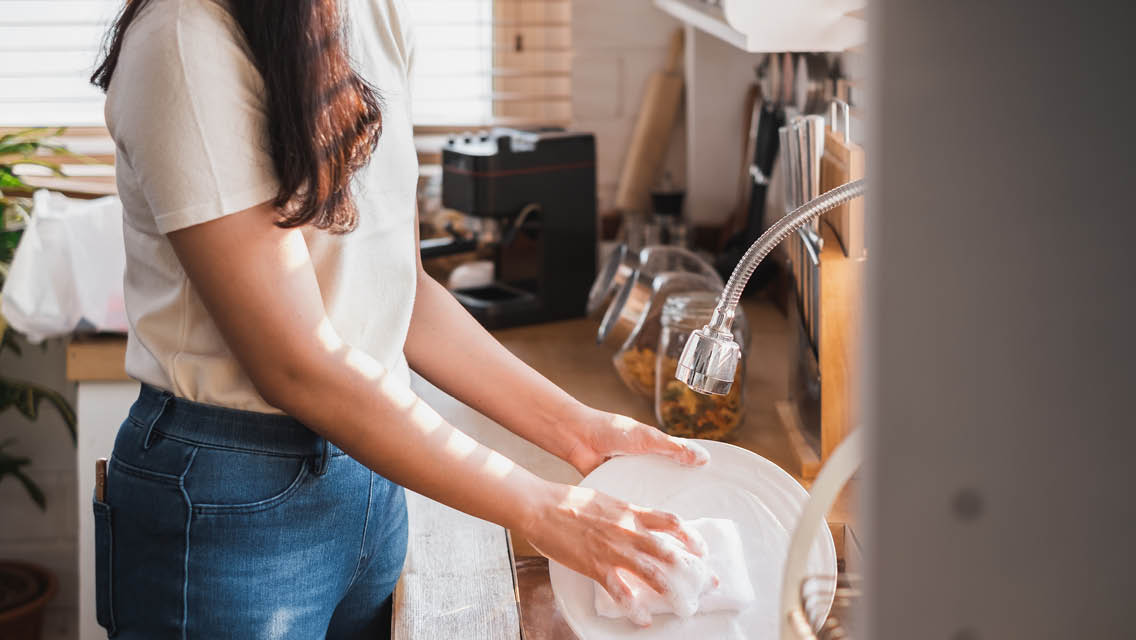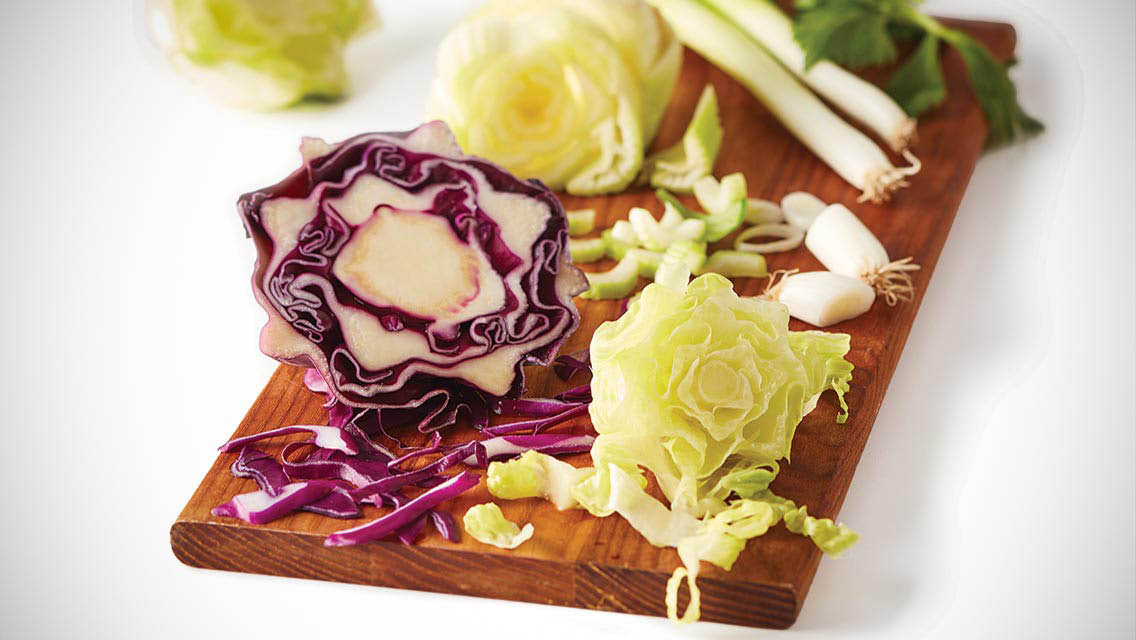You might think your dripping kitchen faucet is just a minor annoyance, but did you know that a single leaky faucet can send more than 3,000 gallons of water per year straight down the drain? That’s a lot of wasted water — enough for 180 showers or 150 loads of laundry.
The average American uses between 80 and 100 gallons of water per day at home, according to the U.S. Geological Survey. As more areas of the country are experiencing frequent drought, you might be looking for ways to reduce your own water waste to help conserve this dwindling resource. The kitchen is a great place to start.
“Most water waste in the kitchen is behavioral,” explains Charles Bohlig, manager of water conservation for the East Bay Municipal Utility District in Oakland, Calif. “It’s important to remember that water has a purpose.”
With that in mind, practice these tips to conserve water in your home kitchen.
1) Fix Leaks and Install Aerators
Faucet leaks are a major source of water waste. “Fixing leaks in a house is typically a No. 1 priority to save water,” says engineer Amy Vickers, a water conservation and efficiency expert and author of Handbook of Water Use and Conservation.
Installing an aerator on your kitchen faucet can conserve water and lower your utility bill. A mesh screen attached to the end of a faucet to control the stream, an aerator mixes air bubbles with the water to reduce the flow. “Aerators provide the functionality of moving water, but without the volume,” explains Vickers. “Your kitchen faucet should flow at a maximum flow rate of about 1 to 2 gallons per minute, and less if only rinsing.” This can help save up to 700 gallons of water per year.
Most newer faucets have aerators, but if yours doesn’t have one, you can install one easily. They’re typically inexpensive, but before purchasing one, contact your utility company to see if they provide them free of charge.
Clean your aerator at least every six months for the best performance.
2) Mind Your Garbage Disposal
One way to eliminate water waste in the kitchen is to stop using your garbage disposal like a garbage can or compost bin. Garbage disposals are meant to handle smaller scraps of food; putting large quantities of waste through the disposal requires a constant stream of water to keep it from clogging the pipes.
Bohlig advises against flushing a lot of food down your drain while letting the water run for lengthy periods. Instead, run your disposal and faucet briefly to wash away small bits of food; toss the larger scraps into your compost bin.
3) Save on Dishes
One-pot and one-pan meals are certainly time savers — and because they cut down on dirty dishes, they’ll also tamp down your water use. (Get started with our sheet-pan recipes at “5 Simple Sheet-Pan Meals.”)
You can also lean into more water-efficient cooking methods. For example, steaming a few cups of vegetables uses only an inch or two of water; to boil those same vegetables, you’d have to fill the pot.
4) Reuse Water
Don’t be so quick to pour leftover water down the drain! Save drinking water for later by storing it in the refrigerator rather than dumping it out. Or give it to your plants.
Some plants can be watered with leftover room-temperature water from tasks such as washing produce or boiling eggs. Just be mindful of what’s in the water: For example, if it contains animal fat, grease, chemicals, or soap, it’s better to let it go down the drain, says Vickers.
“Some communities and states encourage residents to recycle graywater,” she adds. Graywater definitions and codes vary, but in some jurisdictions it includes wastewater that drains out of kitchen sinks, washing machines, bathtubs, and showers. Where allowed, graywater is typically treated and then reused for watering nonedible plants, shrubs, and trees.
5) Upgrade Appliances Strategically
Consider water efficiency when upgrading kitchen hardware and appliances. The Environmental Protection Agency’s WaterSense and Energy Star programs make it easy to identify water- and energy-efficient products.
WaterSense-labeled products, which include faucets, are validated by third-party organizations. They’re guaranteed to perform as well as or better than their standard counterparts while using at least 20 percent less water.
The Energy Star program helps consumers identify energy-efficient appliances, such as dishwashers, that protect the climate, improve air quality, and support public health. A new Energy Star–certified dishwasher uses less than half the energy needed to wash the same dishes by hand — and it can save more than 8,000 gallons of water per year.
6) Compost Kitchen Scraps
Composting saves water by eliminating the need to rinse food scraps down the drain. It also reduces the amount of decomposing food in landfills — the third-largest source of methane emissions in the United States. (To learn more about curbing food waste, see “What You Can Do About Food Waste.”)
If you live in a community that offers curbside compost pickup, you can simply start adding your kitchen scraps to a small countertop bin lined with a compostable bag. If not, check to see if your community offers a food-scrap drop-off location — or, start your own backyard compost with our six-step method at “How to Start Composting.”
7) Make Water Baths
You can conserve water while washing your dishes by hand — as long as you don’t let the faucet run continuously. Instead, make a soapy water bath in a basin or a bowl for washing, and then use a second, clean-water bath for rinsing. This method helps save time and water compared with using a continuous stream to wash and rinse.
You can use a similar method to wash produce: Create one bath for washing and one for rinsing. If possible, use cold water; waiting for a running faucet to heat up wastes both water and energy.
8) Use Your Dishwasher
Running full loads of dishes through a dishwasher requires less water than handwashing — so if you’ve got one, put it to use. New models use 6 gallons or less per cycle, with many requiring just 3.5 gallons. Conversely, if you hand-wash your dishes under running water, you’ll be using up to 2 gallons per minute.
“Even if someone hand-washes efficiently, they are still not going to be able to use the small amount of water that dishwashers use,” says Bohlig. He suggests scraping excess food into the compost bin, then putting dishes right into the dishwasher without rinsing. “Letting water continuously run while rinsing can waste gallons in just minutes.”
9) Think Before You Buy
Did you know that just one roll of paper towels requires an estimated 2.5 gallons of water to manufacture? As a single-use product, paper towels also create significant waste in landfills. Instead, transition to eco-friendly alternatives, such as reusable dishcloths (like the ones featured in “Sustainable Swaps” on page 85).
It may feel challenging to eschew some of your preferred products — but ultimately, being more mindful about consumption is well worth the effort, says Tippi Thole, the eco-minded mom behind the website TinyTrashCan.com.
“All the food we eat requires water to grow and manufacture,” Thole explains. “Reducing consumption of water-intensive foods, like beef and dairy, and eating more plants and unprocessed foods lowers our water consumption, even if we don’t see it with our own eyes.”





This Post Has 0 Comments